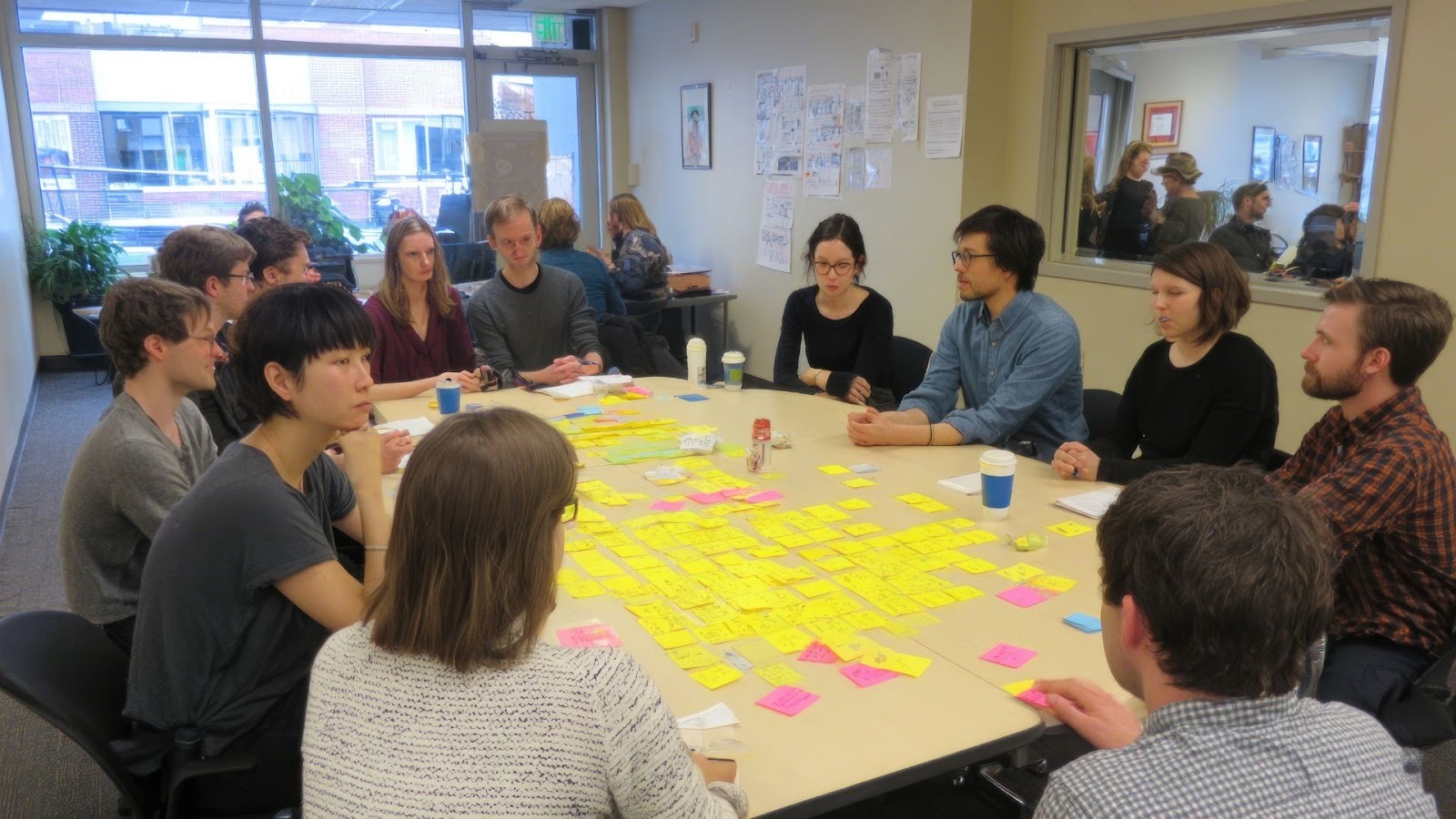Employee engagement remains stubbornly low. Gallup’s latest global workplace report (accessed via login) reveals that only 32% of U.S. employees were engaged in 2024, while worldwide engagement dropped to 23%.
Such disengagement is costly: disengaged employees cost the world 9% of its total global GDP, or $8.8 trillion per year. According to Gallup’s State of the Global Workplace report, when organizations increase the number of engaged employees, they improve a host of organizational outcomes, including profit, retention rates, and customer service.
So, what can leaders do to improve employee engagement and productivity? The answer lies in team-building activities. These activities serve as strategic tools that build trust, creativity, collaboration, and productivity.
This guide examines why group activities matter, highlights different activity types, and provides planning tips. Whether you lead a 50‑person startup or a 5,000‑employee enterprise, you’ll find practical ideas that align with your goals and accommodate remote or hybrid teams.
Key Takeaways
1. Well-designed activities enhance trust, creativity, and collaboration, leading to improved performance and profitability.
2. Schedule monthly team-building events to strengthen morale and offer a mental break, ensuring employees remain motivated and stress-free.
3. Collect feedback and track metrics like engagement scores and productivity to evaluate the effectiveness of group activities and refine future planning.
4. Use scheduling tools like Clockwise to find the best time for team activities, ensuring they don’t clash with high-priority work or meetings.
Why Group Activities Matter?
Engagement influences performance, profit, and retention. Gallup notes that organizations with highly engaged teams enjoy a 23% boost in profitability. Conversely, poor teamwork costs money. The Economist Intelligence Unit found that communication breakdowns lead to lost sales ranging from $100,000 to $ 999,999.
Here are some of the reasons why group activity matters.
1. Build Trust and Collaboration
Group activities encourage employees to engage and understand each other’s strengths, improving team collaboration. This builds a culture of effective communication, leading to higher productivity and better teamwork.
2. Strengthen Morale and Prevent Burnout
Regular team-building activities boost morale by offering employees a chance to bond outside of work tasks. This helps distribute workloads more evenly and reduces the risk of burnout, ensuring your team remains engaged and motivated.
3. Boost Creativity and Innovation
Collaborative activities encourage creative thinking and diverse problem-solving. When employees from different backgrounds come together, they bring fresh ideas that lead to innovative solutions, helping your team stay competitive and forward-thinking.
4. Improve Retention and Productivity
Engaged teams are more likely to stay with your company and perform at a higher level. Group activities create stronger connections and a supportive environment, increasing employee retention and boosting productivity.
5. Deliver Strong ROI
Investing in team-building activities pays off in higher performance. By building trust, creativity, and collaboration, these activities contribute directly to business success, making them a valuable investment for organizational growth.
Group activities are essential for building a high-performing team. So, what types of activities should you consider? Here are 45 fast and effective group activity ideas to improve your team's engagement and collaboration.
Group activities require thoughtful scheduling to ensure maximum participation without overburdening your team. Use Clockwise to find the best time for team-building activities, respecting everyone’s focus time and avoiding conflicts. Start scheduling smarter with Clockwise.
Also Read: A Guide to Task Management: Key Tools and Methods
Top 45 Fast Group Activity Ideas for Team Building

Looking to boost collaboration and morale in your team without spending hours planning? These 45 quick and engaging group activities are designed to get your team energized and working together more effectively.
Use these as inspiration to select exercises that resonate with your team’s needs. Each activity can be adapted for in‑person or virtual formats.
Icebreakers and Connection Activities
Purpose: Ease new members into the team, break down silos, and help colleagues discover common ground.
- Two Truths and a Lie. Each participant shares two true statements and one false statement about themselves. Colleagues guess the lie. This simple game builds familiarity and prompts laughter.
- One‑Word Icebreaker. In small groups, members describe a work topic or recent event with a single word and discuss why they chose it. The exercise sparks candid conversation and surfaces hidden concerns.
- Office Trivia. Host a friendly quiz about company culture, history, or colleagues’ hobbies. Trivia builds camaraderie and quickly breaks the ice.
- What Makes You Tick? Have the team take a simple personality assessment (e.g., DISC or True Colors) and discuss results. Participants learn how different working styles interact.
- Show and Tell. Invite members to share an interest or hobby during a lunch session. This gives introverts equal footing and prompts meaningful conversations.
- Find the Common Thread. Break into groups and challenge them to identify a shared hobby or favorite food. Afterwards, discuss stereotypes and how assumptions can limit collaboration.
Tip: Keep icebreakers brief (10–20 minutes). Use them before larger meetings or at the start of a project to set a positive tone.
Teamwork and Collaboration Exercises
Purpose: Encourage teams to communicate, trust each other, and work towards a common goal.
- Marshmallow Challenge. Provide each group with spaghetti sticks, tape, string, and a marshmallow. Teams must build the tallest freestanding structure. The activity highlights the importance of experimentation and rapid iteration.
- Frostbite. In this problem‑solving game, one participant (the “leader”) is unable to speak while others are blindfolded. Teams must build a shelter from simple materials. It teaches adaptive communication and trust.
- Desert Island Survival. Participants imagine they’re stranded on an island and pick a single item they’d bring. The discussion reveals priorities and encourages creative thinking.
- Lost on the Moon. Provide a list of items and ask the team to rank them according to their usefulness in a lunar survival scenario. Compare group rankings with NASA’s official recommendations to illustrate the power of collective intelligence.
- Escape Room. Either visit a physical escape room or use an online version. Teams solve puzzles under time pressure, requiring collaboration and clear communication.
- Office Scavenger Hunt. Hide clues around the office or virtually via photo prompts. Teams work together to solve riddles. This activity energizes meetings and encourages cross‑departmental interaction.
Creative and Problem‑Solving Activities
Purpose: Spark innovation, encourage divergent thinking, and challenge assumptions.
- Brainwriting. Each participant writes down three ideas for a problem. After a few minutes, everyone passes their paper to the next person, who builds on the ideas. The process continues until all ideas are thoroughly explored.
- Rube Goldberg Machine Challenge. Teams design a chain‑reaction machine to complete a simple task (e.g., popping a balloon). According to Matter’s research, creative challenges release endorphins and dopamine, strengthening the bond.
- Reverse Charades. Instead of one person acting out a word, the entire team acts while a single person guesses. This twist requires coordination and fosters laughter.
- Lego Serious Play. Provide Lego kits and ask participants to build models representing a goal or challenge. Teams then share their stories, which reveal perspectives and spark deep discussions.
- Hackathon or Innovation Jam. Allocate half a day for teams to solve a business problem or create a prototype. Encourage cross‑functional collaboration and reward the most creative solution.
- Photography Challenge. Give each team a theme, such as “customer journey,” “team values,” or “innovation,” and ask them to take photos that represent it. Present the images and discuss the insights they illustrate.
Strategic and Goal‑Oriented Activities

Purpose: Align teams with organizational objectives and build leadership skills.
- Crisis Simulation. Present a hypothetical crisis (e.g., data breach or supply‑chain disruption). Teams develop a response strategy, assign roles, and communicate under pressure. This builds decision‑making skills and highlights the value of preparation.
- Business Model Canvas Workshop. Use Alexander Osterwalder’s canvas to brainstorm a new product or service. Teams collaborate to fill out customer segments, value propositions, and revenue streams. The exercise encourages strategic thinking.
- SWOT & Future‑back Planning. Form small groups to identify strengths, weaknesses, opportunities, and threats for a new initiative. Then use future‑back planning to outline steps needed to reach a long‑term goal. This method encourages scenario planning and reflective thinking.
- Team Charter Development. Each team co‑creates a charter that clarifies roles, goals, norms, and decision‑making processes. A clear charter improves psychological safety and reduces role ambiguity.
- Leadership Swap. During a recurring meeting, assign a different team member to lead the session. Rotating leadership builds empathy and communication skills while revealing hidden talent.
Innovative & Collaborative Challenges
Purpose: Push the team to collaborate across boundaries and think like innovators.
- Design Thinking Sprint. Facilitate a short sprint where teams empathize with end‑users, define a problem, ideate, prototype, and test solutions. Encourage experimentation and quick learning.
- Cross‑Departmental Hackathons. Bring together people from multiple departments to solve a company‑wide challenge (e.g., improving onboarding).
- Collaborative Innovation Challenges. Ask teams to propose new services or process improvements. Let colleagues vote on the best idea and provide resources for a pilot.
- Idea Market. Participants create “start‑ups” and pitch them to their peers using pretend currency. Colleagues invest in the ideas they believe in. The activity teaches persuasion and valuation and uncovers promising concepts.
Fun & Outdoor Activities
Purpose: Increase morale, physical health, and connection through shared experiences outside the office.
- Volunteering Day. Organize a community service day where teams contribute to local nonprofits. This fosters purpose and highlights your company’s values.
- Field Day or Office Olympics. Plan a series of light‑hearted competitions such as sack races, tug of war, and three‑legged races at a nearby park. Friendly competition energizes participants and encourages teamwork.
- Nature Hike or Wellness Walk. Schedule a group hike or walking meeting. Fresh air and movement stimulate creativity and help reduce stress.
- Cooking or Mixology Class. Book a hands‑on class through providers such as Classpop! Guided cooking classes offer an intimate atmosphere and spark creativity.
- Company Retreat. Use services like TeamOut to plan off‑site retreats with activities, meals, and accommodations. Off‑site experiences deepen relationships and allow space for strategic reflection.
- Scavenger Hunt (Outdoor). Similar to the indoor version, participants solve clues around the city or on company grounds, promoting collaboration and problem‑solving.
Virtual and Hybrid Activities
Purpose: Engage remote and hybrid teams who can’t participate in in‑person events.
- Virtual Escape Room. Many providers offer online escape rooms where teams solve puzzles via video conference. It’s an engaging way to build collaboration across distances.
- Online Trivia or Game Show. Use tools like Kahoot! or QuizBreaker to host trivia games. Rotate hosts to keep sessions fresh.
- Remote Coffee Chat Roulette. Randomly pair employees for 15‑minute virtual coffee chats. These informal conversations help colleagues from different teams connect and reduce isolation.
- Asynchronous Brainstorming Boards. Use digital whiteboards (e.g., Miro, FigJam) to brainstorm ideas over a week. Team members can contribute at their convenience, promoting inclusivity across different time zones.
- Virtual Workshops. Invite experts to host online workshops, such as yoga, art, mindfulness, or cooking. This supports well-being and encourages people to share experiences outside of work tasks.
- Digital Book or Podcast Club. Choose a book or podcast episode relevant to your business, then discuss insights during a virtual session. Encourages continuous learning and fosters discussion.
Small‑Group and Large‑Group Ideas

Small‑Group Activities (Teams under 10)
- Personal Timeline Sharing. Ask each participant to draw a timeline of significant life or career events and share with the group. This deepens empathy and understanding.
- Storytelling Circles. Each member shares a personal story related to work values or customer experience. It’s intimate and promotes vulnerability.
- Speed Appreciation Rounds. Team members quickly express gratitude for specific actions of their peers. Positive feedback builds trust and motivates the team.
Large‑Group Activities (Teams of 50+).
- Giant Murals or Collaborative Art Projects. Divide the group into sub‑teams that each design a piece of a mural representing company values. Assemble the mural at the end for a tangible symbol of unity.
- Flash Mob Preparation. Coordinated dance or music performances require practice and trust. A flash mob breaks routine and creates a memorable shared experience.
- Parallel Track Challenges. For large groups, run multiple challenges simultaneously (e.g., trivia, scavenger hunt, creative workshop). Rotate teams through stations to maintain engagement.
It’s one thing to have ideas, but how do you turn them into successful experiences? This checklist will guide you through the essential steps of planning and running group activities that align with your goals.
Looking to streamline your team's scheduling for these activities? Explore how Clockwise's Flexible Meetings can automatically reschedule internal meetings to optimal times, ensuring uninterrupted collaboration.
Also Read: A Guide to Automated Scheduling- Benefits, Types, and Implementation
How to Plan and Run Group Activities: A Practical Checklist
Planning and executing group activities effectively involves balancing several factors to ensure they align with both your team’s and organization’s goals. Below is a practical checklist to help guide your planning process.
1. Align Activities with Goals
Start by defining the purpose of the activity. Are you aiming to improve communication, boost innovation, onboard new employees, or simply offer a fun break from work? Set clear, measurable goals to ensure the activity supports the desired outcomes.
For example, you could focus on improving engagement scores or reducing project completion time. Research indicates that well-targeted activities produce better results than general, non-specific events.
Questions to ask:
- What do you want to achieve with this activity?
- Have you set measurable goals, like improving communication or engagement?
2. Consider Group Size and Diversity
The size and diversity of your team are critical factors in selecting the right activity. Small teams (5–10 people) might benefit from more intimate, reflective activities, while larger teams require scalable challenges that engage everyone.
- For smaller teams: Focus on activities that allow for deep discussions or strategy-based games.
- For larger teams: Choose activities that can be broken into smaller sub-teams or have a competitive element.
- Diversity considerations: Ensure the activity accommodates different personalities, physical abilities, and comfort levels with certain types of challenges. For example, offering options like mental puzzles or physical games allows everyone to participate.
3. Provide Psychological Safety
A critical element for successful group activities is ensuring participants feel safe to share ideas and engage fully. Clearly communicate that these activities are meant for growth, not evaluation.
Setting ground rules for respectful communication is key to fostering a safe environment where team members feel valued. Leaders should model vulnerability, which will encourage others to participate authentically.
Tips for success:
- Communicate that activities are about growth, not assessment.
- Set and model respectful communication ground rules.
- Encourage openness and trust among participants.
4. Respect Workloads and Schedules
Team-building activities should enhance productivity, not disrupt it. Consider your team’s existing workloads and schedules to ensure the activity doesn’t add stress. Timing matters, especially during busy periods.
Use tools like Clockwise to find optimal times for activities that respect focus hours and avoid overlapping with important meetings.
Key considerations:
- Avoid scheduling during high-stress periods.
- Use scheduling tools to find times that accommodate all team members, including remote or hybrid employees.
- Provide buffer time before and after activities to ensure smooth transitions.
5. Gather Feedback and Measure Impact
After each activity, gather feedback from participants to assess its effectiveness. You can do this through surveys or informal conversations. Tracking key metrics like employee engagement, productivity, or team cohesion before and after the activity will help measure its impact and guide future activities.
Ask questions such as:
- What went well in the activity?
- What did you enjoy most about the activity?
- Was it relevant to your work?
- Did it help improve communication or collaboration?
- How could we improve the experience next time?
- Did the activity meet its objectives?
6. Make It Continuous
Group activities shouldn’t be a one-time event. For lasting results, incorporate them into the regular rhythm of your organization. Monthly icebreakers, quarterly challenges, and annual retreats keep the team engaged and aligned with company values. These ongoing activities strengthen bonds and reinforce a positive organizational culture.
- Plan regular activities (e.g., monthly, quarterly) to keep the team engaged.
- Celebrate successes and recognize individual and team contributions to reinforce a positive environment.
By following this checklist, you can plan and run group activities that are engaging, efficient, and aligned with your team’s needs, ensuring that every event delivers value for your organization.
Once you’ve planned your activities, the next step is scheduling them efficiently without disrupting your team’s workflow. With Clockwise, you can optimize this process and ensure that team-building activities seamlessly align with your team’s calendar.
Also Read: Best Workflow Management Tools for 2025
Maximize Productivity and Team Engagement with Clockwise
Planning group activities becomes complex when calendars are packed and teams span time zones. That’s where Clockwise, a smart calendar management tool, comes in. Clockwise optimizes schedules so you can focus on meaningful collaboration rather than logistics.
- Automated Scheduling for Recurring 1:1s and Team Events. Stop playing calendar ping‑pong. Clockwise finds the best time for meetings and recurring 1:1s, considering both parties’ availability and preferences. It avoids low‑energy hours or conflicting priorities.
- Protected Focus Time and Buffers. Clockwise reserves focus blocks before and after meetings, enabling participants to prepare and capture action items without being rushed. This ensures group activities do not disrupt deep work.
- Smart Conflict Resolution. When conflicts arise, Clockwise automatically steps in to resolve it. Critical meetings are preserved without sacrificing personal development sessions or group activities.
- Workload Visibility Across Teams. Managers can see the distribution of meetings and focus time for their direct reports. This helps them schedule group activities when everyone has the mental bandwidth to engage.
- Seamless Integration With Daily Tools. Clockwise connects with Google Calendar, Slack, and other collaboration platforms. Reminders and updates appear where your team already works, reducing the risk of missed events. Slack integration can trigger notifications reminding participants about upcoming group exercises.
Clockwise’s features support the principles outlined above: aligning activities with goals, respecting workloads, and enabling psychological safety by reducing last‑minute scheduling stress. By automating logistics, you free leaders to focus on designing impactful experiences.
Conclusion
Employee disengagement and burnout are costly challenges. However, when you invest in intentional group activities, you turn employee connection into business value. Group activities, ranging from icebreakers and creative challenges to strategic workshops and outdoor adventures, create the shared experiences that build trust and align teams with your mission.
Use feedback to refine your approach and maintain a cadence that integrates collaboration into your culture. When you combine thoughtful activities with smart scheduling tools like Clockwise, you remove logistical friction and make teamwork an integral part of daily work. The result is a resilient, innovative, and engaged workforce.
FAQs
1. Why are group activities important in a corporate environment?
Group activities help your team build trust, improve communication, and innovate together. Companies investing in team‑building increase productivity and improve retention. They also boost morale and creativity.
2. How often should we organize group activities?
Aim for a mix of short and long activities throughout the year. Monthly icebreakers or lunch‑and‑learn sessions keep connections strong, while quarterly innovation challenges and annual retreats provide deeper opportunities for collaboration. The cadence should align with your goals and respect workload pressures.
3. What are quick group activities for busy schedules?
Two truths and a lie, one‑word icebreakers, and speed appreciation rounds can be completed in 10–20 minutes. Virtual trivia games or coffee‑chat roulettes are great for distributed teams. Use Clockwise to find slots that minimize schedule disruption.
4. How do we include remote employees in group activities?
Choose activities that translate online: virtual escape rooms, remote scavenger hunts, asynchronous brainstorming, and digital book clubs. Pair remote participants with on‑site colleagues in small groups to foster inclusivity. Always provide a video or messaging platform to facilitate interaction.
5. How do we measure the impact of group activities?
Use surveys, engagement scores, and productivity metrics. Track changes in employee retention, project completion time, and cross‑department collaboration. Evaluate whether teams feel more connected and whether communication improves. Quantitative measures complement qualitative feedback to demonstrate ROI.


.gif)
.png)



